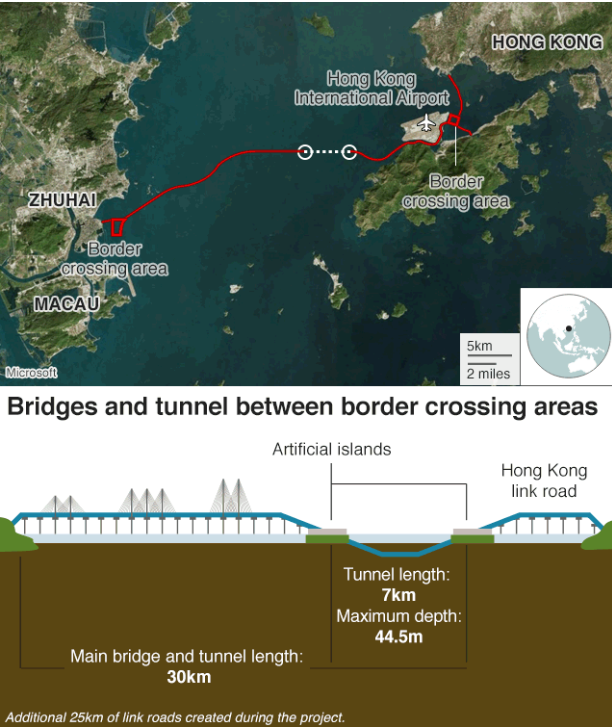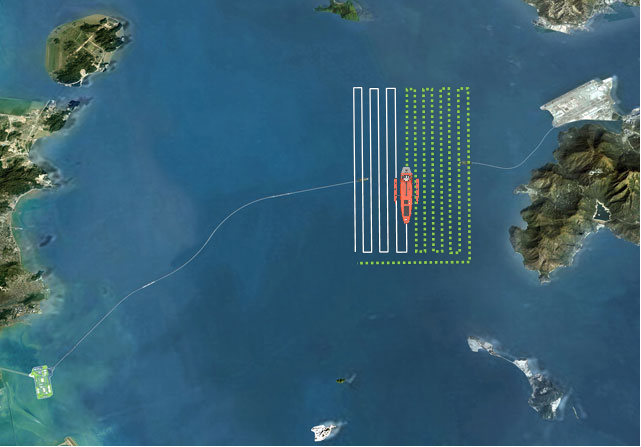The bridge cost about $20bn (£15.3bn). About 30km of its total length crosses the sea of the Pearl River delta. To allow ships through, a 6.7km section in the middle dips into an undersea tunnel that runs between two artificial islands.

Even though the constructing is done, there’s still a tremendous amount of work to maintain the bridge.
For example, there’s 355,000㎡ concrete outer surfaces of 236 piers in the sea, 1,326,000 ㎡ paint coat of the 22.9km long girder, 128000 ㎡ internal and outside surface of paint coat of 7 bridge towers, the sedimentation and settlement of 5.6km deep underwater tunnel and etc, all of which need regular monitoring and maintenance.
There’s no way to reach the requirement of engineering maintenance if only by the traditional monitor and survey methods fully operated by the human.
So the Hong Kong-Zhuhai-Macao Bridge Authority is planning to develop an intelligent robot program which can acquire the bridge data structurally by which the authority can evaluate and measure the condition of the structural components of the bridge intelligently and accurately.
Unmanned surface vessels developed by OceanAlpha are playing a vital role in this program. The OceanAlpha USVs will be applied in monitoring the surface of the under-water pier, measuring the seafloor geographic and geomorphic situation around the pile foundations and the channels, monitoring the sedimentation and settlement of the immersed tunnel, and monitoring the sedimentation of the artificial islands.
Monitoring & detecting for the surface of the under-water pier
A medium size, 3.5m long, survey USV carrying a side scan sonar and topographic sonar will be monitoring the pier surface by recording monitoring time, pier number, sonar image, latitude, and longitude position of each pier.
It takes 15min for the USV to monitor each pier, including the sailing time, a total of 10 days to survey all 236 piers.

Monitoring route
Seafloor geographic and geomorphic survey
The engineering maintenance requires monitoring and detecting the changes of underwater geomorphology around the pier foundation in a regular pattern.
A medium-size survey USV carrying a multi-beam echo sounder will be carrying out this mission by collecting and outputting sonar image, bathymetric data, rendering the bathymetric map, anchor mark, and the contour of any surface object on the seafloor.
It takes the USV about 10 days to finish the seafloor geographic and geomorphic survey around the pier foundation, and 4 days to survey all four channels.
Undersea tunnel monitoring
A large-size, 5.6m long, survey USV carrying a sub-bottom profiler will be collecting data including the thickness of sludge, the situation of the buried objects and the condition of the tunnel.
The distance of survey lines is between 100m to 200m, depending on the depth of water and the settlement of the sensor.
It takes 2 days for the USV to monitor the sedimentation and placement condition of all immersed tunnels.

Survey route
Monitor the sedimentation of the artificial islands

Survey route
A large-size USV carrying a multibeam echo sounder and a 3D laser scanner will be collecting the waterline position of the islands, as well as the structure images of the island coast both on the water surface and underwater.
The distance of each survey line is between 50m to 150m, depending on the depth of water and sensor setting.